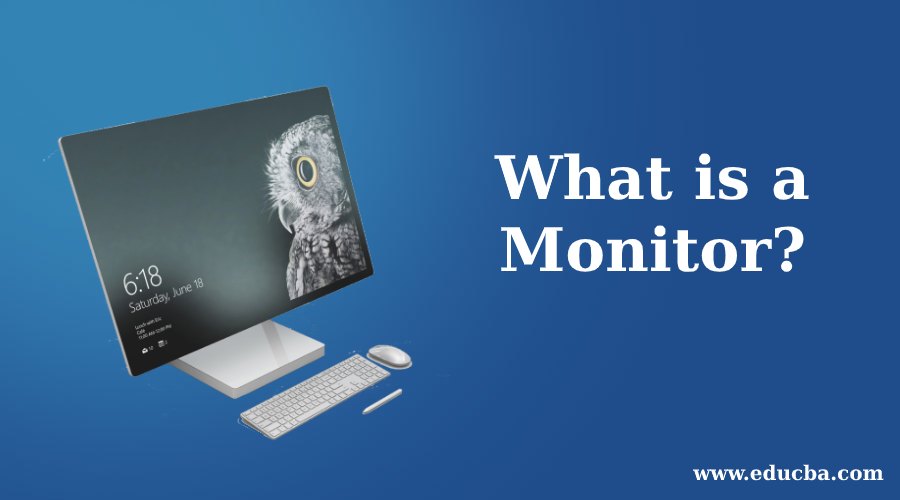Updated May 31, 2023

Introduction to Monitor
A monitor is an electronic output system called a Video Display (VDT) or video display (VDU) unit. The display of information created by a related computer through a video card is rendered by photos, text, video, and graphics. Although it is almost like a Screen, it’s much more resolution than a Screen. Xerox unveiled the first electronic monitor as part of the Alto computer system on 1 March 1973. Older monitors were designed using a Cathode Ray Tube (CRT) and featured a fluorescent screen, which made them heavy and wide. This design allowed them to save space on the desk. Today, flat-panel technology, usually backlit with LEDs, makes all monitors. Compared to older CRT monitors, new screens take up less room on the desk.
Hanns-G, Acer, Dell, Sceptre, Samsung, LG Electronics, HP, and AOC are the most common brands of computer monitors. You can buy monitors directly or through retailers such as Amazon and Newegg from these manufacturers. Typically a DVI, HDMI, or VGA port connects a display. The USB, DisplayPort, and Thunderbolt are additionally included. Ensure that both devices accept the same connection type before investing in a new display for use with your computer. For example, do not buy a monitor with an HDMI port if your computer can only accept a VGA link. Many video cards and displays have several ports, but checking compatibility with different types of devices is still necessary.
Troubleshooting Monitor Issues
Calculating a monitor’s output typically involves multiple variables rather than relying solely on a single attribute, such as the total display size. These include the aspect ratio (horizontal length versus vertical length), power consumption, refreshing rate, contrast ratio (the concentration of bright colors versus the darkest colors), reaction time (how much time it takes to switch from active to inactive to another active pixel), display size, etc. You can fix many things yourself, but it’s best not to open the package for safety reasons. Take your monitor to a professional if you can not resolve the problem using the suggestions listed here.
1. Screen Flickering: Screen scanning can be overcome with a change in the display’s refresh rate, which the Windows Control Panel can achieve.
2. Color Problems: You will disable it to eliminate the magnetic deference it creates if you have an older CRT display that has difficulty displaying colors or when you have a series of colors on the edges of the screen. See Computer Monitor How you can degauss if you need assistance.
3. No Image: Do you have a computer that displays nothing on the screen? Read our Computer Monitor Test Guide for measures, including testing the display for loose connections, correctly describing the luminosity and more.
4. Setup: Monitors are typically available instantly via plug-in and play. Consider upgrading your video card system if the video on the computer doesn’t show as you believe it should. See how to upgrade Windows drivers if you want assistance
Types of Monitor
There are various types of Monitor such as follows:
1. Flat Panel Monitors
They are lightweight displays that take up less room. Compared with CRT displays, they use less electricity. Such devices are more effective because they are not harmful. Such displays cost more than CRTs. PDAs, laptop computers, and cell phones use flat-panel displays. Such displays come in various sizes, such as 15, “17,” 18 “& 19” and beyond. Two glass plates of a flat panel monitor render the show. Several methods can trigger the material within those plates.
2. Touch Screen Monitors
These devices are also considered input systems. Instead of using a mouse or keyboard, it helps users to communicate with the computer using a finger or design. When the users touch the screen, an event occurs and transmits it to the processing controller. Screens like these contain images or words to assist users in communicating with the device. It receives users’ input by clicking the menus or icons on the screen. Touchscreen monitors have various styles; three specific types are given below.
3. LED Monitors
It’s a flat-screen monitor for a diode display that emits light. The weight is low, and the depth is brief. It uses an LED panel as the light source. Large and small devices like laptop screens, mobile telephones, television, computer monitors, and tablets use LED displays. They do use many other electronic devices.
4. OLED Monitors
It is an effective, lighter, thinner, and better refreshing feature and contrast than LCDs with a modern, flat parking display technology. It consists of the position between two conductors of various thin films. These emissive displays do not require a backlight. Top-tier tablets and smartphones primarily utilize these displays, which offer enhanced picture quality.
Recommended Articles
This is a guide to What is a Monitor? Here we discuss the introduction to Monitor, its different types, and its troubleshooting monitor issues in detail. You can also go through our other suggested articles to learn more –


